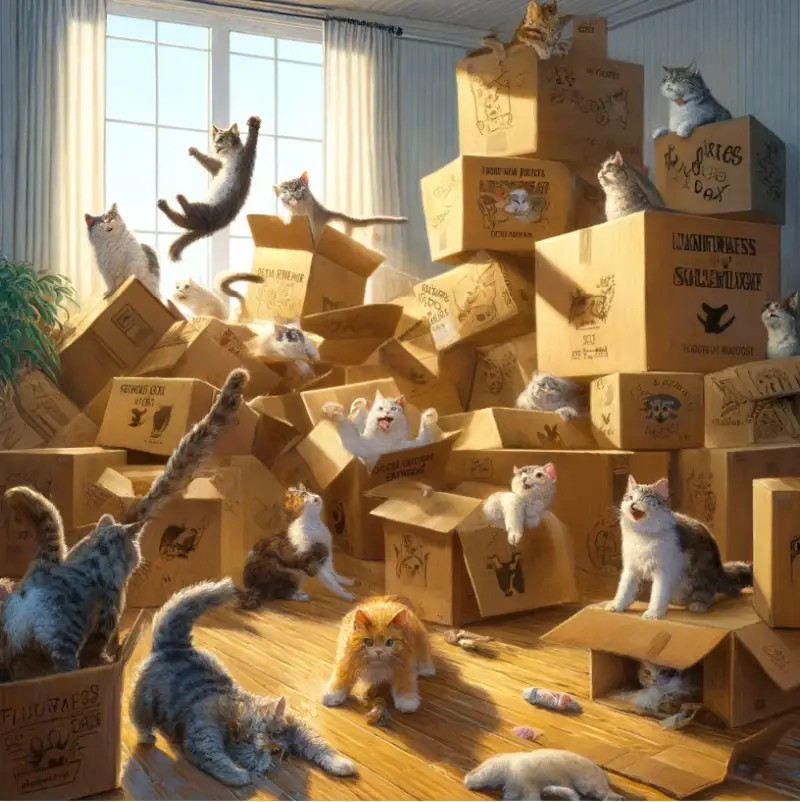Cats and cardboard boxes seem to go hand in hand, baffling and amusing cat owners and observers alike. This strange fascination is not just a whim, but is deeply rooted in a cat’s natural instincts and behavioral patterns.
To understand why cats are attracted to cardboard boxes, we need to take a closer look at some scientific explanations that cover aspects of cat biology, psychology and environmental needs.
First, cats are attracted to cardboard boxes because of their instinctive need for safety and security. In the wild, small spaces allow cats to hide from predators and sneakily observe their surroundings without being seen. Cardboard boxes offer a similar secluded haven where cats feel protected and in control of their environment.
The need for a safe hiding place is a deep survival instinct, even for house cats who live in predator-free environments, and is highly valued in the cat world, where a box provides a sense of security and privacy and hiding is synonymous with safety.

Another thing that makes cardboard attractive to cats is its insulating properties: cardboard provides a cozy, warm place for your cat to rest. This warmth is especially appealing to cats, who prefer high temperatures to relax and sleep.
A cat’s thermoneutral zone (the temperature range where they don’t need to expend extra energy to cool or warm themselves) is about 86-97 degrees Fahrenheit (30-36 degrees Celsius), which is considerably warmer than a human’s, so the warmth of a cardboard box is irresistibly cozy for them.

Additionally, cardboard’s texture is attractive to cats; it provides an ideal surface for scratching, a natural behavior for cats. Scratching allows cats to remove the outer layer of their claws, visually mark their territory with their scent glands, and stretch their muscles. The sound and feel of their claws digging into the cardboard is satisfying and encourages this natural behavior. Additionally, the slight springiness of cardboard under the claws provides a unique tactile sensation that many cats find preferable over other materials.
Behaviorally, cats are inquisitive creatures who enjoy exploring new environments and objects. Cardboard boxes introduce an element of novelty and exploration; they provide an opportunity for play and investigation, stimulating a cat’s natural curiosity and hunting instincts. Cats will jump in and out of the box, hide in the box, or even use it as a chase spot, mimicking the natural behavior they would exhibit while hunting in the wild. This stimulation is especially important for indoor cats, as it provides mental and physical exercise, prevents boredom, and promotes overall health.

Psychologically, the confined space of a cardboard box may also provide an environment in which cats can more effectively manage stress. A study published in the Journal of Applied Animal Behavior Science found that cats that were given a hiding box were less stressed than cats that were not. The study suggests that the hiding box helps new cats adjust to their environment, lowering stress levels and encouraging more exploratory behavior. Being able to escape into a small, controlled space allows cats to escape stressful stimuli and recover from anxiety, similar to a coping mechanism.
Finally, the smell of the cardboard itself may be attractive to cats. Cardboard is often made from wood pulp and may have a natural odor that attracts cats. Although not as strong as catnip, the natural odor of cardboard may intrigue your cat and provoke exploration. Additionally, over time, the box will absorb your cat’s own odor, reinforcing it as a familiar and comfortable place to be.

summary
Cats’ fascination with cardboard boxes is a multifaceted behavior that is rooted in a cat’s natural instincts, biological needs and psychological preferences. Cardboard boxes offer a unique combination of safety, comfort and entertainment that makes them irresistible to cats. This behavior highlights the importance of understanding and responding to your pet’s natural instincts and environmental needs to ensure their mental and physical well-being. By providing simple pleasures like cardboard boxes, cat owners can enrich their pets’ lives in meaningful ways, fostering a sense of security, comfort and happiness in their home environment.
Editor’s Pick – Furhaven Multi-Level Cardboard Cat House for Indoor Cats
We love this two-tiered cardboard cat house that has a corrugated scratching surface with a rough, bark-like texture, and blank inside and outside so cats and their owners can decorate the walls and space to their heart’s content. Get it here.
2 Image credit: Depositphotos





